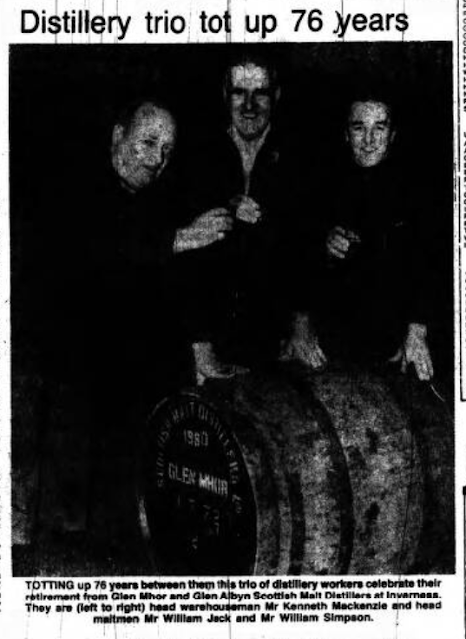Distillers to close Maltings
This report published in the Aberdeen Evening Express on 19th September 1980, confirms the end of malting at both, Glen Albyn and Glen Mhor distilleries. Traditional malting had ended at each the sites, with Glen Mhor ending floor malting in June 1949. In comparison, Glen Albyn did not make that move towards Saladin boxes until 1961.
It is interesting to see that both distilleries are suggested to be amongst some of the smallest maltings owned by Scottish Malt Distillers. Glen Mhor was certainly blighted by a limitation in its original design, highlighted by subsequent upgrades - while the onsite maltings remained untouched.
In fact, we know through research and justification for the Saladin Boxes at Glen Mhor, that Glen Albyn had to step in on a regular basis to provide malting capacity support. Moving to a more mechanical means, reduced the expected burden on labour costs, which would have involved hiring a new team to work the floors.
In this 1980 report, unfortunately 14 men across both sites were to lose their roles. If the Saladin Boxes weren't on site, then this number would have been considerably higher. Both maltings would fall idle and as far as we know, were not repurposed. This is a common site when visiting other distilleries in Scotland, where some of the original malting buildings are closed off and left to wait a new purpose. If anything, based on current trends and a new appreciation of what floor malting can bring to the character of a whisky, we may be seeing more floors opening in the coming decade.
Through my research of Glen Mhor, there is a general sense of working at the distillery (and I presume, Glen Albyn as well), being a job for life. You would work your way up to a new position and graduate through the production process of a distillery, until reaching the all-important role of a still man.
It might be a coincidence, but we do have the following article published in the Aberdeen Press & Journal, on 5th November 1980:
This underlines the experience at both of the distilleries, with both head maltmen (it is unclear who worked at Glen Mhor or Glen Albyn exactly), with William Jack and William Simpson taking up retirement; no doubt prompted by the lead announcement. Perhaps they saw the writing on the wall for both distilleries, with demand reducing for whisky and the culture of overproduction taking root, as warned by William Birnie, formerly of Glen Mhor.
There would be no passing of the baton to a younger generation, as SMD preferred to bring in malt to both sites, potentially from its sizeable maltings at Glen Ord distillery. In harsh economic terms, the Saladin Boxes were not as cost efficient as large scale industrial maltings. It was cheaper to bring in malt by road than utilise the existing capacity.
This was very much one of the early nails in the coffins for most of the distilleries that would close in the early 1980s. Many of these distilleries were coming to the end of their natural lifespan and would require sizeable investment to remain viable. In the face of falling demand, it made more financial sense to extend more efficient and newer distillery builds than continue with decaying producers. The sites of several distilleries had become increasingly valuable as they occupied central locations in growing communities and this was very true of Inverness, where land was at a premium.
Another version of this article was originally published on the Glen Mhor research website.




Comments
Post a Comment